
Sarasvathi, The Goddess of Learning

Saraswati or Sarasvathi, means the flowing one. She is the goddess of knowledge and learning in Hinduism.
She is extolled in the Vedas both as a divinity and as the sacred river by the same name.
Originally, she was a river goddess. From the references found in the Rigveda, we may deduce that she was more popular in the Rigvedic times than all the present day goddesses of Hinduism, including goddess Ganga.
Later, in the puranic lore she became popular as the consort of Brahma and the goddess of knowledge and learning.
She has seven sisters and helps the gods by destroying their foes. She also dispels the darkness of our minds.
Saraswati in the Vedic tradition
The early Vedic people lived on the banks of the river Sarasvathi.
At the height of the Sindhu Sarasvathi civilization, the river was held in high esteem, which is evident from the several references to it found in the Rigveda.
The hymns of the Rigveda extoll the river frequently while they make no mention of the river Ganges. They describe her as the best mother, best of goddesses, hero's consort, mighty flood, balmy one, the all surpassing one, who illumines every pious thought, grants progeny, perfects the devotion of worshippers and protects them from storms and foes. They beseech her to come to the sacrificial altar from the highest heaven as well as from the lofty mountains.
The river used to flow in western India through what is now the Thar desert. It dried up eventually with changes in the climate.
Symbolism
Saraswati actually means "the one who flows".
Saraswati is a river of knowledge that flows in the highest heaven of Brahma and descends into our minds through the doors of learning to become established in us as knowledge and wisdom. She is purifier in our quest for liberation.
She personifies in humans civilized behavior, refined tastes and artistic talent. She is worshipped by all students.
Saraswati grants wisdom, knowledge, creativity and intuition for the flowering of our minds and refinement of our character.
In her images, she is shown with four hands, holding a Veena, Saraswati is Vagdevi, speech personified. Speech is central to our lives and activities on earth.
It also distinguishes us from rest of the animal kingdom.
Speech was also at the root of all Sanskrit mantras and religious activity. One can therefore understand the importance of this divinity in Hindu pantheon.
Saraswati is the goddess of light who dispels our ignorance and inner darkness through her grace. Even gods worship her for developing proficiency in different fields.
Description and imagery
She is addressed with different names by her devotees. Sarada (giver of essence), Vagesvari (controller of speech), Bharathi, Kalavathi, Brahmi (consort of Brahma) and Veenadhari (holder of the Veena) are some of her most popular names.
In the images, she is generally depicted as a beautiful and graceful goddess in spotless white clothes, with four hands, seated on a lotus seat, holding a Veena, a musical instrument, with one of her hands and resting it on her lap or, with the remaining three holding a book, a rosary and lotus respectively. She is usually depicted with water or a rive in the background, suggestive of her association with the river Saraswati, and peacock standing nearby.
These objects sometimes vary, but they generally symbolize her connection with learning and knowledge. Her vehicle is generally either a swan or a peacock.
The swan symbolizes beauty, grace and wisdom, while the peacock symbolizes the same in addition to its ability to deal with desires and ignorance (snakes)
Suggestions for Further Reading
- Hindu Gods - Lord Ganesha
- God and Self in Hinduism
- Goddesses of Hinduism, Their Symbolism and Significance
- Purusharthas in Hinduism
- The History, Antiquity and Chronology of Hinduism
- Ashrama Dharma in Hinduism
- Hinduism and Buddhism
- Death and Afterlife in Hinduism
- Hinduism and Divorce
- Hinduism and Adultery
- Hinduism, Food and Fasting
- The Future of Hinduism
- Good and Evil in Hinduism
- The Hindu Marriage, Past and Present
- What is Maya in Hinduism?
- The Origin and Definition of Hindu
- Hinduism and Polygamy
- Hinduism and polytheism
- Hinduism and Premarital Relationships
- God and Soul, Atma and Paramatma, in Hinduism
- About Suicides in Hinduism
- Religious Tolerance in Hinduism
- Violence and Abuse in Hinduism
- Traditional Status of Women in Hinduism
- Ashtanga Yoga of Patanjali
- About Hanuman or Anjaneya
- Hinduism and Same-sex Marriage
- Perspectives on What Karma Means
- Hinduism - The Role of Shakti in Creation
- Significance of Happiness in Hinduism
- Hindu God Lord Shiva (Siva) - the Destroyer
- The Role of Archakas, Temple Priests, in Hinduism
- Hinduism - Gods and Goddess in the Vedas
- Essays On Dharma
- Esoteric Mystic Hinduism
- Introduction to Hinduism
- Hindu Way of Life
- Essays On Karma
- Hindu Rites and Rituals
- The Origin of The Sanskrit Language
- Symbolism in Hinduism
- Essays on The Upanishads
- Concepts of Hinduism
- Essays on Atman
- Hindu Festivals
- Spiritual Practice
- Right Living
- Yoga of Sorrow
- Happiness
- Mental Health
- Concepts of Buddhism
- General Essays
Notes: The images of Saraswati used in this article are the public domain in the United States, and those countries with a copyright term of life of the author plus 100 years or less.